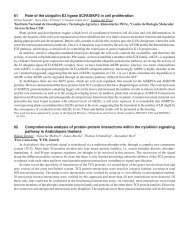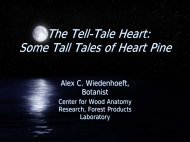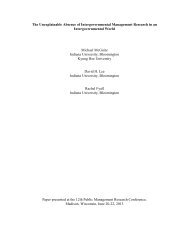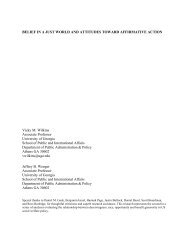Full Abstract Book - Wisconsin Union - University of Wisconsin ...
Full Abstract Book - Wisconsin Union - University of Wisconsin ...
Full Abstract Book - Wisconsin Union - University of Wisconsin ...
Create successful ePaper yourself
Turn your PDF publications into a flip-book with our unique Google optimized e-Paper software.
ICAR 2011<br />
<strong>University</strong> <strong>of</strong> <strong>Wisconsin</strong>–Madison<br />
272 The Role <strong>of</strong> the Conserved Protein, CACTIN, in Arabidopsis. An Exciting, Essential, and Unique<br />
Eukaryotic Gene.<br />
Katherine Baldwin, Patrick Masson<br />
<strong>University</strong> <strong>of</strong> <strong>Wisconsin</strong>, Madison, WI, USA<br />
CACTIN is a conserved gene found across eukaryotes and encodes a protein without recognizable functional domains. Mutations<br />
in the CACTIN gene result in lethality in Drosophila, C. elegans, Toxoplasma, and Arabidopsis. In flies, CACTIN plays a role in the NFkB<br />
pathway. There is no recognized NF-kB pathway in plants or C.elegans. Our studies using Arabidopsis suggest that CACTIN plays<br />
a critical role in embryogenesis and possibly a function in root gravitropism. Like in animal systems, Arabidopsis fluorescently tagged<br />
CACTIN localizes to nuclear speckles. By yeast-two-hybrid, we found that CACTIN binds to a putative component <strong>of</strong> the spliceosome.<br />
We propose that CACTIN maybe a peripheral part <strong>of</strong> the eukaryotic spliceosome. We present further experiments in Arabidopsis to test<br />
this hypothesis as well as examining its functional conservation between plants and animals.<br />
273 AGD1, a Class 1 ARF-GAP that Localizes to Punctate Bodies <strong>of</strong> the Endomembrane System, Regulates<br />
Multiple Components <strong>of</strong> Root Hair Growth in Arabidopsis<br />
Cheolmin Yoo 1 , Satoshi Naramoto 2 , J. Alan Sparks 1 , Hiroo Fukuda 2 , Elison Blancaflor 1<br />
1<br />
Samuel Roberts Noble Foundation, Ardmore, Oklahoma, USA, 2 <strong>University</strong> <strong>of</strong> Tokyo, Tokyo, Japan<br />
Mutations to the Arabidopsis thaliana AGD1 gene, which encodes a class 1 Adenosine Diphosphate (ADP)-Ribosylation Factor<br />
(ARF)-Guanosine Trinucleotide (GTPase) Activating Protein (GAP), triggers the formation <strong>of</strong> wavy root hairs. To better understand<br />
the position <strong>of</strong> AGD1 within the intricate signaling pathways that govern root hair polarity, we studied the localization <strong>of</strong> a functional<br />
AGD1-green fluorescent protein (GFP) fusion in living root hairs, evaluated various components <strong>of</strong> root hair tip growth in agd1 mutants,<br />
and analyzed double mutants <strong>of</strong> agd1 and other loci involved in root hair development. AGD1- GFP decorated punctate bodies in the root<br />
hair that were reminiscent <strong>of</strong> fluorescently labeled endomembrane compartments. However, AGD1-GFP foci were distinct from several<br />
endomembrane markers and localization <strong>of</strong> AGD1 punctate structures persisted despite exposure to Brefeldin A or Wortmannin. Targeting<br />
<strong>of</strong> RabA4b-GTPase, ROP2-GTPase and phosphatidylinositol-4-phosphate, which are essential components <strong>of</strong> tip growth maintenance,<br />
were altered in agd1 root hairs. Furthermore, dampened tip cytosolic calcium oscillations and disrupted tonoplast dynamics were observed<br />
in root hairs <strong>of</strong> agd1. Double mutant analysis indicated that RHD4, which encodes a phosphatidylinositol-4-phosphate phosphatase, is<br />
epistatic to AGD1. On the other hand, double mutants to AGD1 and ACT2, a root hair-expressed vegetative actin is<strong>of</strong>orm, displayed<br />
additive root hair defects. Taken together, our results support a model that positions AGD1 downstream <strong>of</strong> phosphoinositide metabolism<br />
in controlling cytoskeletal, cytosolic calcium , ROP2 and RabA4b-mediated root hair polarity.<br />
274 Dissecting The Requirement For Plant RanGAP1 Subcellular Targeting And GAP Activity For Its<br />
Cellular And Developmental Functions<br />
Joanna Boruc, Thushani Rodrigo-Peiris, Iris Meier<br />
The Ohio State <strong>University</strong>, Columbus (OH), USA<br />
RanGAP is an accessory protein <strong>of</strong> Ran signaling, which is involved in nucleocytoplasmic transport, spindle organization and<br />
post-mitotic nuclear assembly. These functions <strong>of</strong> RanGAP are conserved across higher eukaryotic organisms. However, we have<br />
recently discovered a novel function for higher plant RanGAP in cytokinesis, possibly reflecting the phragmoplast-dependent division<br />
<strong>of</strong> plant cells. We have shown that Arabidopsis RanGAP1 is a continuous marker <strong>of</strong> the cell division plane and it is required for proper<br />
cell division and plant development, likely independent <strong>of</strong> its role in nucleocytoplasmic trafficking. We have created Arabidopsis mutant<br />
lines with decreasing RanGAP levels and increasing phenotypic severity. These mutants are a valuable tool to dissect the requirement for<br />
the GAP activity and/or mitotic subcellular addresses <strong>of</strong> RanGAP for its role in plant cell division and development. We have identified<br />
a point mutation in the targeting domain <strong>of</strong> RanGAP that blocks all subcellular positioning during mitosis, but which still complements<br />
a temperature-sensitive yeast RanGAP mutant strain. Moreover, we have constructed point mutations that block the GAP activity, but<br />
do not interfere with the subcellular positioning. Through the complementation <strong>of</strong> the mutant plants with these mutant versions <strong>of</strong> the<br />
protein, we are currently testing which features <strong>of</strong> Arabidopsis RanGAP are required for its roles in cell division and plant development.<br />
These data will further evaluate our hypothesis <strong>of</strong> a separate evolution <strong>of</strong> RanGAP targeting mechanisms and its subfunctionalization<br />
in different kingdoms.<br />
275 GT-2 Family Transcription Factors Regulate Cell Growth in Arabidopsis<br />
Christian Breuer, Ayako Kawamura, Keiko Sugimoto<br />
RIKEN Plant Science Center<br />
Plant organ growth is regulated by two distinct processes, first, the cell number which is controlled by cell proliferation, and second,<br />
the size <strong>of</strong> individual cells, which is regulated by cell expansion and cell growth. In Arabidopsis, various studies have shown a positive<br />
correlation between cell size and ploidy, but the molecular mechanisms underlying this observation are still unclear.<br />
We have previously identified GT-2-LIKE1 (GTL1) as a repressor <strong>of</strong> ploidy-dependent cell growth in trichomes. GTL1 is a nuclear<br />
protein, and further expression analysis revealed that GTL1 is expressed in various cell types, except meristematic cells, throughout plant<br />
development, suggesting that GTL1 might function as a general transcriptional regulator <strong>of</strong> plant cell growth. Ubiquitous expression<br />
<strong>of</strong> GTL1 arrests early seedling growth, and thus, we have used strong cell- and tissue-specific promoters to allow an assessment <strong>of</strong> the<br />
potential role <strong>of</strong> GTL1 in regulating growth, ploidy and size <strong>of</strong> plant cells. Detailed examination <strong>of</strong> these ectopic lines confirms that GTL1<br />
Poster: Cell Biology
















